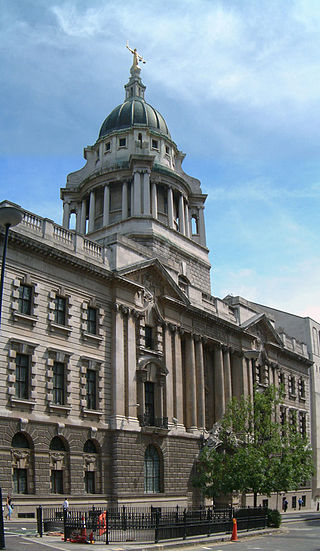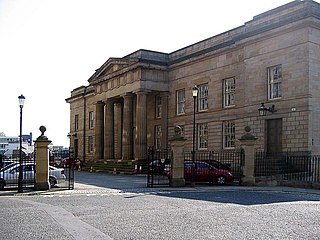
Durham, is a cathedral city and civil parish on the River Wear, County Durham, England. It is an administrative centre of the County Durham District, which is a successor to the historic County Palatine of Durham.

The Central Criminal Court of England and Wales, commonly referred to as the Old Bailey after the street on which it stands, is a criminal court building in central London, one of several that house the Crown Court of England and Wales. The street outside follows the route of the ancient wall around the City of London, which was part of the fortification's bailey, hence the metonymic name.

Elvet is an area of the city of Durham, in County Durham, in England. It is situated on the opposite side of the River Wear from Durham Cathedral and forms the south-eastern part of central Durham. Elvet is currently unparished. Historically, the word elvet means "swan" or "swan-stream", from the Old English elfetu or ilfetu. The Swan and Three Cygnets, a public house on Elvet Bridge, is a reminder of the historical name given to this part of the city.

HM Prison Durham is a Georgian era reception Category B men's prison, located in the Elvet area of Durham in County Durham, England. Built in 1819, the prison continues to be operated by His Majesty's Prison Service. Women prisoners were moved in 2005 due to overcrowding and suicides.

The Bristol Crown Court is a Crown Court venue which deals with criminal cases at Small Street in Bristol, England. The building, which was completed in 1868, was previously used as a main post office before it was converted for judicial use in the early 1990s.

The Victoria Law Courts is a red brick and terracotta judicial building, which accommodates Birmingham Magistrates' Court, on Corporation Street, Birmingham, England. It is a Grade I listed building.

The Colleges of Durham University are residential colleges that are the primary source of accommodation and support services for undergraduates and postgraduates at Durham University, as well as providing a focus for social, cultural and sporting life for their members, and offering bursaries and scholarships to students. They also provide funding and/or accommodation for some of the research posts in the University. All students at the University are required to be members of one of the colleges.

County Hall is a historic former courthouse in Cuckoo Lane in Coventry's Cathedral Quarter. It is a Grade II* listed building.

St Albans Town Hall, sometimes known as the Old Town Hall or The Courthouse, is a 19th-century building in St Albans, Hertfordshire, England. The building, which now accommodates the St Albans Museum, is a Grade II* listed building.

Gloucester Crown Court is a Crown Court venue which deals with criminal cases at Bearland, Gloucester, England. The court, which is located at the back of Gloucester Shire Hall, is a grade II listed building.

The Moot Hall is a courthouse at Castle Garth in Newcastle upon Tyne, England. The structure, which overlooks the Tyne Bridge, is a Grade I listed building.
The palatine courts of Durham were a set of courts that exercised jurisdiction within the County Palatine of Durham. The bishop purchased the wapentake of Sadberge in 1189, and Sadberge's initially separate institutions were eventually merged with those of the County Palatine.

Reading Crown Court is a judicial facility in Reading, Berkshire. It is a Grade II listed building.

County Hall, formerly the Old Sessions House, is a municipal building in Sandling Road in Maidstone, Kent, England. The county hall, which is the headquarters of Kent County Council, is a Grade II listed building.

Lincoln Crown Court is a judicial facility in Lincoln, Lincolnshire. It is located on the western side of the grounds of Lincoln Castle and is a Grade II* listed building.

The Old Shire Hall is a former municipal building in Old Elvet, Durham. The building, which was the headquarters of Durham County Council from 1898 to 1963, is a Grade II listed building.

Paisley Sheriff Court is a municipal structure in St James Street, Paisley, Renfrewshire, Scotland. The complex, which was the headquarters of Renfrewshire County Council and is currently used as a courthouse, is a Category A listed building.

York Crown Court is a Crown Court venue which deals with criminal cases at York Castle in York, England. It is a Grade I listed building.

The Oxford Combined Court Centre is a Crown Court venue, which deals with criminal cases, as well as a County Court venue, which deals with civil cases, in St Aldate's, Oxford, England.

The Stafford Combined Court Centre is a Crown Court venue, which deals with criminal cases, as well as a County Court venue, which deals with civil cases, in Victoria Square, Stafford, England.




















